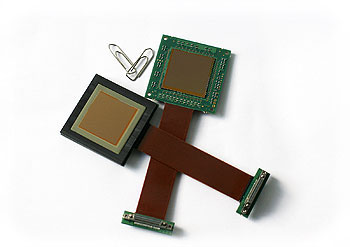
Image Sensors for Extreme Temperatures
DUISBURG, Germany, Sept. 21, 2010 — Image sensors used as parking aids in cars or used for quality control in production systems must be able to withstand the very high temperatures that often prevail in these environments. Now, research scientists have produced a CMOS chip that functions even at a temperature of 115 °C.
More and more car manufacturers are equipping their vehicles with image sensors; for example, to register the presence of pedestrians or vehicles in the blind spot or to detect obstacles while parking. The sensors must be able to function in extremely high temperatures and in blazing sunlight. If they are installed behind the rear view mirror or on the instrument panel, for example, they can get very hot. The Fraunhofer Institute for Microelectronic Circuits and Systems has developed a CMOS sensor that can withstand temperatures ranging from –40 to +115 °C. The CCD image sensors available up to now fail when the temperature goes beyond about 60 °C.
“Our chip is not only heat-resistant, it even functions at arctic temperatures,” said Werner Brockherde, head of Department Optical Sensor Systems at Fraunhofer IMS.

A CMOS sensor developed by Fraunhofer Institute for Microelectronic Circuits and Systems can be connected directly to an electronic image intensifier. (Image: Fraunhofer IMS)
The scientists succeeded in developing pixels that exhibit an extremely low dark current. This reduction of residual current, which flows in complete darkness, makes it possible to capture very high quality images even in extreme heat.
“It was not easy to achieve a low dark current,” Brockherde said. “An increase in temperature of just 8 °C doubles the dark current, resulting in image noise and reduced dynamics. Ghosting occurs in the form of artifacts or fuzziness and degrades the image.”
A further special feature of the sensor is its image size of 2.5 × 2.5 cm. For special applications with weak illumination or for capturing images in the IR or UV range, this offers the advantage that the sensor can be connected directly to an electronic image intensifier. The sensor has a resolution of 256 × 256 pixels, and its high dynamic range or exposure latitude of 90 dB provides increased contrast and optimized detail accuracy both in shadow as well as in very bright areas.
The CMOS chip supports cameras with synchronous as well as asynchronous shutters. The synchronous shutter prevents motion artifacts — for instance, when recording rapid movements — reducing movement fuzziness. The rolling shutter permits a higher image frame rate and continuous image recording. The effect of this is to minimize image noise.
“We produced the sensor in a standard process using 0.5 μm CMOS technology in our own semiconductor factory. We also produce special components here for industrial customers,” Brockherde said. In addition to the automotive sector, he said he can see further potential markets. “Our chip is suitable for deployment in chemical and steel production facilities, where it can be used for process and quality control. Very high temperatures prevail, for example, in rolling mills where sheet metal is produced.”
The CMOS image sensor will be shown at the Vision trade fair from November 9 to 11, 2010, in Stuttgart.
For more information, visit: www.fraunhofer.de
Published: September 2010